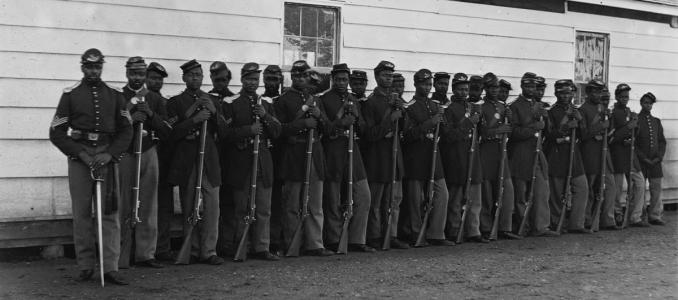Virginia State Standards Fulfilled by this Lesson:
USI.9 /VUS.7
f)/c) describing the effects of war from the perspectives of Union and Confederate soldiers (including African American soldiers), women, and enslaved African Americans.
Lesson Learning Objectives:
- Students will investigate how free African Americans built communities and families in both the North and South in the years before the Civil War.
- Students will learn how some free Blacks in the South were pressured or coerced into performing service for the Confederate army as servants and laborers, though not as soldiers.
- Students will explore how and why thousands of free Black men from throughout the country enthusiastically volunteered for service in the Union army and navy, despite facing prejudice and other obstacles.
- Students will consider the military experiences of several free Black Union soldiers and sailors born in Albemarle county, including the hardships of life in the field, the dangers of disease, and the horror of battle.
- Students will analyze primary sources, recognizing how historians come to know more about the past through documents written for practical purposes and how they put those primary sources into conversation with the existing scholarship.
Approximate Length of Time: 3-4 hours
Resources:
- Background & General Reading:
- Casey Bowler, “Black Virginians in Blue (Part 1): Before the Civil War,” Black Virginians in Blue (BVIB).
- Casey Bowler, “Black Virginians in Blue (Part 2): Civil War,” BVIB.
- New York Public Library, “The Migration North,” In Motion: The African-American Migration Experience.
- Susanna Michele Lee, “Free Blacks during the Civil War,” Encyclopedia Virginia.
- Jaime Amanda Martinez, “Black Confederates,” Encyclopedia Virginia.
- Free Black Virginians in Blue:
- Casey Bowler, “‘Begging Their Chance to Lead the Charge’: Black Virginians and the Louisiana Native Guards,” BVIB.
- Matthew H. Wallace, “No Quarter Expected, No Quarter Given: The Brutal Experience of Black Virginians in Blue at the Battle of the Crater,” BVIB.
- Matthew H. Wallace, “Forgotten Triumph: Union Victories at the Battle of Chaffin’s Farm,” BVIB.
- Matthew H. Wallace, “Bittersweet: Black Virginians in Blue at the Battle of Honey Hill and Beyond,” BVIB.
- William B. Kurtz, "Alexander Caine: From Philadelphia Barber to Union Sailor to World Traveler,” BVIB.
- BVIB Primary Sources:
Activity Procedure:
- Ask all students to complete the general readings. This can be done either as homework or in class within small groups. These essays contain a wealth of information, so ask students to write short (3-5 sentences) summaries of each.
- Divide the students into small groups and assign each group one of the one of the essays on Free Black Virginians in Blue. Ask each group to summarize the essay in a 3-5 minute presentation to the class, including, if possible, relevant images (these can be collected on the BVIB website or from other reliable sources such as the Library of Congress: https://www.loc.gov/rr/print/list/081_cwaf2.html)
- In the same small groups, ask students to read through each of the assigned primary sources and to discuss the implications of each. What do these pension applications tell us about the experience of free Black servicemen and their families following the war? What challenges did they face? What do these documents tell us about the gender dynamics between Black women and Black men? Is there anything surprising about how these claims are framed? How might a historian use this document to tell a story about the past or a particular historical actor?
- As homework, have students write a short (2-3 page) essay discussing the experiences of free Black servicemen, before, during, and after the Civil War. Students should note how these experiences both mirrored and differed from the experiences of those African American servicemen who had been enslaved at the beginning of the Civil War. The most thoughtful essays will also consider how the common wartime and postwar experiences of these servicemen and their families helped create a more cohesive African American identity after the Civil War.
Lesson plan created by: Ian Iverson
Image: "District of Columbia. Company E, 4th U.S. Colored Infantry, at Fort Lincoln" (Courtesy Library of Congress)

